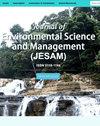Melanomacrophage Centers in Nile Tilapia (Oreochromis niloticus L.) as Biomarker for Carbamate Exposure
IF 0.3
4区 环境科学与生态学
Q4 ENVIRONMENTAL SCIENCES
引用次数: 0
Abstract
Melanomacrophage centers are aggregates of pigment-containing cells found in the animal’s hematopoietic tissues. Changes in its characteristics have been used to assess the influence of pesticide exposure, and as tools for potential monitoring for fish and environmental health. This study aimed to evaluate the pesticide-induced hepatic and splenic melanomacrophage center responses in Nile tilapia (Oreochromis niloticus L.) following exposure to fenobucarb in varying lengths of exposure. Five test groups were exposed to constant dose of fenobucarb at 0.08 mg L-1at different periods (0, 7, 14, 21, and 28 days). Fenobucarb only induced significant changes in the splenic melanomacrophage centers. Splenic melanomacrophage centers significantly increased in number in response to the increasing lengths of exposure. Increasing trend of size and cover was also observed, however, significant difference was only detected at 28 days exposure period. Significant difference in hemosiderin and lipofuscin pigments was also detected at 28 days exposure which suggests tissue destruction after prolonged exposure. This study confirms the potential of melanomacrophage centers as a sensitive biomarker for fenobucarb exposure indicated by the changes in its characteristics, particularly in the spleen.尼罗罗非鱼(Oreochromis niloticus L.)黑色素巨噬细胞中心作为氨基甲酸酯暴露的生物标志物
黑色素巨噬细胞中心是在动物的造血组织中发现的含有色素的细胞的聚集体。其特性的变化已被用于评估农药暴露的影响,并作为潜在的鱼类和环境健康监测工具。本研究旨在评估尼罗罗非鱼(Oreochromis niloticus L.)在不同时间暴露于非诺布后,农药诱导的肝脏和脾脏黑巨噬细胞中心反应。五个试验组在不同时期(0、7、14、21和28天)暴露于0.08 mg L-1的恒定剂量的非诺布卡。非诺布卡仅诱导脾脏黑巨噬细胞中心发生显著变化。脾脏黑巨噬细胞中心的数量随着暴露时间的增加而显著增加。大小和覆盖率也有增加的趋势,但只有在28天的暴露期才发现显著差异。在暴露28天后,还检测到含铁血黄素和脂褐素色素的显著差异,这表明长期暴露后组织破坏。这项研究通过其特征的变化,特别是在脾脏中的变化,证实了黑巨噬细胞中心作为非诺布卡巴暴露的敏感生物标志物的潜力。
本文章由计算机程序翻译,如有差异,请以英文原文为准。
求助全文
约1分钟内获得全文
求助全文
来源期刊

Journal of Environmental Science and Management
ENVIRONMENTAL SCIENCES-
CiteScore
0.90
自引率
0.00%
发文量
10
审稿时长
2 months
期刊介绍:
The Journal of Environmental Science and Management (JESAM) is an international scientific journal produced semi-annually by the University of the Philippines Los Baños (UPLB).
JESAM gives particular premium to manuscript submissions that employ integrated methods resulting to analyses that provide new insights in environmental science, particularly in the areas of:
environmental planning and management;
protected areas development, planning, and management;
community-based resources management;
environmental chemistry and toxicology;
environmental restoration;
social theory and environment; and
environmental security and management.
 求助内容:
求助内容: 应助结果提醒方式:
应助结果提醒方式:


